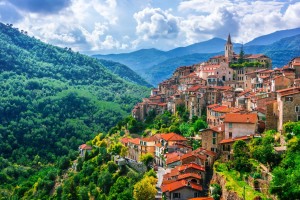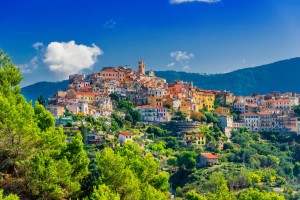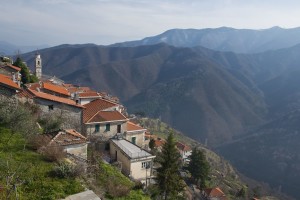The Province of Imperia in the westernmost part of Liguria might not break any size records, yet remains highly popular due to its charming location. The long coastal strip that, to the west, extends far beyond the French border to nearby Nice and the mountainous foothills of the Parco naturale regionale delle Alpi Liguri in the hinterland brings delightful topographical variety to proceedings. In addition, there are two absolute sleeper hits waiting along the coastline of the Tyrrhenian Sea: the provincial capital Imperia and Sanremo, the latter being very popular among music fans. In addition, the Province of Imperia harbours eight places that are part of the private association “I borghi più belli d’Italia” – and it’s high time to tell you more about them.

©Bigstock.com/monticello
Apricale
Narrow, steep alleys lead through the old mountain village with a population of about 620. The former settlement of Celts and Romans saw Apricale created during the 9th century around the Apricus rock, on which an imposing fortress would to be built a couple of centuries later. The central Piazza Vittorio Emanuele II is ideal to start your short tour of the village. Stop at the Oratorio San Bartolomeo with its charming baroque façade and belltower. For some wild reason, there’s a bicycle on the roof of the parish church Purificazione di Maria Vergine’s spire. The old rock alleys with rock arcades, roofed passages and wall paintings whisk you away to days long gone.
Cervo
A prong at the coast is home to Cervo with its almost car-free historic centre. Due to the steep incline, only parts of it can be driven on using small, three-wheel Ape cars. The village with a population of 1,100 is protected by the old castle Castello di Cervo to one side – partially open for tours and, among other things, home of the local museum. Furthermore, the magnificent baroque church San Giovanni Battista is most certainly worth a visit. Moreover, the tranquillity in these small alleys with a gorgeous view of the sea plus the many palaces that indicate the former wealth of the population will simply wow and woo you. Additionally, Cervo is very popular among campers offering a whopping four campsites, and it attracts culture aficionados to Liguria with its international festival for chamber music.
Diano Castello
This municipality with about 2,250 inhabitants is only nine kilometres from the provincial capital Imperia and can certainly be counted among the larger locations of the private association of particularly beautiful places. The medieval centre can be traced back to a 10th century hill-site fortress of which little survived. However, there’s an abundance of churches and sacral buildings in Diano Castello, such as the Chiesa di San Nicola with its lavish baroque endowments or the Romanesque Chiesa di Santa Maria Assunta with its ostentatious triptych above the main altar. Several festivities, such as the medieval and folkloristic Corteo Storico in autumn and the nativity set exhibition around Christmas, round out what makes this beautiful place unique.
Lingueglietta
Technically speaking, Lingueglietta (about 50 inhabitants) is part of the municipality Cipressa, yet it counts among the most beautiful places of Italy by itself. That is mostly due to very much maintaining its original look with a medieval structure that overwhelmingly remains intact. Given to the ancestors of the later ruling feudal family Lengueglia in 1049, the village was built around the castle that merged with the Chiesa di San Pietro in the 16th century, thereby creating an exciting contrast between sacral and secular architecture. Another place worth seeing is the Chiesa della Natività di Maria Vergine. Despite receiving a new marble portico in the 17th century, Lingueglietta’s Romanesque parish church – as the village itself – managed to retain its original charm.

©Bigstock.com/monticello
Perinaldo
Founded by Count Rinaldo di Ventimiglia in the 11th century, Perinaldo (approx. population of 830) stands tall at the spring of the Verbone stream. Several renowned astronomers were born here, such as Giovanni Domenico Cassini who once headed the then leading Parisian observatory. The divinely clear skies over Perinaldo must’ve inspired him. Cassini, originator of a dynasty of astronomers, had the observatory in the town hall and a museum dedicated to him. Several astronomical sights throughout the village, such as the planetarium or a copy of the solar system in Via Giovanni Domenico Cassini, form a fascinating contrast to the medieval architecture.
Seborga
We stay with Ventimiglia for now. The territory that now makes up Seborga (approx. 270 inhabitants) used to be part of his family’s shire from the 8th century onward and was first documented as Castrum de Sepulchro in 954. There’s a medieval site surrounded by what remains of the old town wall with its four gates on the almost triangular layout of the village that loves to call itself “Principality of Seborga.” The baroque Chiesa parocchiale di San Martino with its diligently restored façade, the Palazzo dei Monaci (formerly owned by Benedictine monks), and the small 13th century prayer chapel Oratorio di San Bernardo situated on the way into the village are among the most beautiful sights of Seborga. Plenty of saint’s festivities take place here, too, such as Festa di San Bernardo with a big parade on August 20th and the Festa di San Martino on November 11th with a procession dedicated to the village’s patron saint.
Taggia
Saracen pirates used to plague the town (current population approx. 13,700) near the bathing resort Arma di Taggia. Even hefty walls couldn’t curb their destructiveness and looting. Still, despite multiple sieges, Taggia managed to retain most of its original look. Beyond the glorious medieval town centre you’ll come across numerous ancient Roman elements – cobbled narrow roads, rock gates and arches – alluding to the former status as a major trade port. Several palaces, works of arts and monuments can be found throughout Taggia, such as the magnificent gates made out of black rock or the majestic baroque façade of the Santuario della Madonna Miracolosa with a statue that supposedly moved its eyes twice before. Don’t miss out on checking out the late 15th century Dominican monastery with its Gothic cloister and large art gallery.

©Bigstock.com/Faabi
Triora
The popular mountaineering village Triora (approx. 360 inhabitants) was heavily damaged by wars. That’s why, when strolling through the medieval centre, you will repeatedly see ruins and partially collapsed buildings. They form a stark contrast to many an architectural highlight, such as the collegiate church Collegiata di Nostra Signora Assunta, its origins remaining a mystery to this very day. The stylistic plurality with predominantly Romanesque and Gothic basic ideas plus neoclassical renovations wows as much as the late Gothic belltower. The Oratorio di San Giovanni Battista was originally supposed to be the diocesan museum and currently houses numerous art treasures, such as the astounding statue of John the Baptist by Anton Maria Maragliano.
The Province of Imperia is one of Italy’s hidden treasures without a doubt. Numerous stunning places with medieval centres whisk you away on a journey into the past, accompanied by many a surprise. There’s something to discover and experience at every corner ranging from idyllic strolls through narrow alleys to magnificent views of nature and even the sea to thrilling festivals. Imperia is always worth a visit, and the province’s most beautiful places come with several sleeper hits that will introduce you to an entirely different Italy.